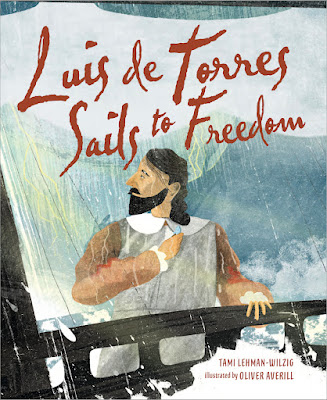Review: Luis de Torres Sails to Freedom
Luis de Torres Sails to Freedom
by Tami Lehman-Wilzig, illustrated by Oliver Averill
Kar-Ben Publishing (imprint of Lerner Publishing Group), 2023
On the eve of the date when all Jews must leave Spain, July 31, 1492, Yosef ben HaLevi Halvi faces a choice. He must leave the country or become a converso, a hidden Jew who is publicly Christian. He had already taken the Christian name Luis de Torres, but de Torres chooses to leave. Taking a position as a translator on a ship heading to the Far East, he hopes to find a place where he could openly practice his Judaism. When de Torres says goodbye to his family as they celebrate Shabbat in a hidden room, his nephew Jacobo presses a good luck charm in his hand, a silver hamsa. Jacobo hopes it will keep his uncle safe.
Arriving at the ship that will take him from Spain, the commander tells him they will leave on July 31. That day is Tisha B’Av, the Jewish day of mourning commemorating the destruction of the Holy Temple in Jerusalem. It would be bad luck to leave then. But by July 31 all Jews must leave Spain. What to do? In the hold of the ship, de Torres discovers a group of sailors as alarmed as he is. These sailors must be hidden Jews too! Holding the hamsa, de Torres pleads with the commander to delay their departure. The problem is solved when a big storm rolls in. The commander delays but allows them to stay on the ship, so that they avoid violating the decree to leave Spain by the end of July. Did the hamsa save de Torres and his fellows?
Historians speculate that many Jews escaping Spain sailed with Columbus. In this historical fiction narrative, Tami Lehman-Wilzig delves into the true facts of Columbus’ journey, outlined in the back matter, and builds a story about religious freedom. The back matter also contains information about Tisha B’av, hamsas, and the expulsion of the Jews from Spain. The textured illustrations by Oliver Averill add roughness and are in somber browns and grays, evoking the danger to the Jews. Averill uses brighter blues and greens and smoother patterns on the hamsa and in scenes where freedom is at hand.
Beginning with the rituals of Shabbat, candle lighting, challah, and wine for kiddush, this tale has positive Jewish content. Set in the world of Sephardic Spanish and Portuguese Jews, it outlines the dangers they faced in history. This narrative is appropriate for the target age, and might cultivate a curiosity about the arrival of Jews in the New World that could send a child or adult reader to explore further.
Note from editor Heidi Rabinowitz: Christopher Columbus has an important role in this story, but is only referred to in the text as the "commander." He is depicted with shadowy grey skin, perhaps as another way to try to keep him out of the spotlight and keep the focus on de Torres. Columbus has become a controversial figure in recent times, held to account as a colonizer instead of revered as an explorer. Columbus's voyage may have been a good thing for de Torres and other hidden Jews on board, but it was a tragedy for the indigenous people he was soon to meet. Ironically, de Torres' freedom comes at the expense of the freedom of the natives of the Caribbean, and the lack of acknowledgement of this in the back matter is a missed educational opportunity.
Reviewer Dena Bach studied Illustration at the Massachusetts College of Art and Design and has an MA/MFA in Children’s Literature and Writing for Children from Simmons University. Currently the illustration editor of The Shmooze, she has worked as a bookseller, bookkeeper, fine artist, calligrapher, illustrator, writer, and a teacher of children from ages two to fourteen. No matter how many children’s books she reads a day, the magical pile of books on her bedside table never seems to get any smaller.



Comments
Post a Comment